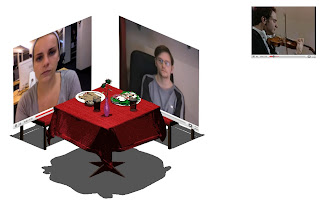
Sunday, December 26, 2010
Wednesday, December 8, 2010
Stevie Hanley: Tantric Wilderness amidst the Urban Chaos, A review by Evelyn Krampf for P.S. I Love You
Rain Down the Harvest, 2010. Courtesy the artist.
Opposite Rain Down the Harvest is Utopia through Fine Art (Alfred Bierstadt). Here we find more spare pencil drawing, reminiscent of the Rocky Mountains, surrounded by negative space, bring to mind the great perspective paintings created during the first exploration of the West. And seemingly unrelated, drifting in the center, is the focal point of the piece – a garish painted rainbow. The splash of color here in the midst of a spare austere background is a tactic seen in Hanley’s other works, and evidences his sense of humor and the cynical cheer in his pieces. This piece combines static gray elements and flashes of color with precision, and combines naturalistic pastoral scenes with icons that seem out of place.
Utopia through Fine Art (Alfred Bierstadt), 2010. Courtesy Dr. Ulrich Köstlin.
Next to Rain Down the Harvest hangs the Goyaesque You’ve Got AIDS In Your Hair. What appears to be a disembodied woman’s head floats in black. Her head is titled sympathetically, and she has the classical features of a Gibson girl, except for Hanley’s brutal brush strokes. Heavy pitiless sweeps of brown color the subject’s nose, cheekbones and forehead. Her eyes and lips remain white and gray, giving her the look of a partially made-up corpse. The rabid smudging of white paint above her head and the dribble of gray paint down the bridge of her nose completes the look of the lady; more Frankenstein’s wife than Gibson girl after all. At closer examination, the viewer may notice that the delicate creature has the smudgy suggestion of a mustache and goatee, adding another complex layer to this examination of still beauty.
You’ve Got AIDS In Your Hair, 2009. Courtesy the artist.
In the back room the exhibition closes with Hanley’s imposing Mountain Base. A large black demonic head floats in the center of the piece, it’s long tongue sticking out. It rests in the center of a forest, elegant slender trees surround the devil-creature, and birds fly toward the sky. The piece again contrasts the stillness found in nature with a suggestion of violence, of some uncontrollable, terrifying force that cannot be understood by human beings. This seems like a simple juxtaposition at first glance, but as one’s eye traverses the paper, one notices the careful placement of bright blended colors, the streaks of gold glitter, giving something modern and playful to the work. The birds fly upwards, but at different angles, as though frightened by some sudden catastrophy, adding another layer of narrative suggestion. Hanley’s work urges the viewer to meditate on wilderness, but in a whole new way, encouraging the viewer to see nature as at once peaceful and precarious for the visitor. Hanley takes the tradition of natural perspective paintings of the West, but reminds the viewer of the true awe and fear that the nature inspires, and how vulnerable we truly are. The exhibition is a must for the art enthusiast, closing the 11th of December.
Mountain Base, 2010. Courtesy the artist.
Also on view...
Boys Swim, 2008. Courtesy Dr. Hubert Lehmann.
A short excerpt from Daniel Spaulding's Stevie Hanley, "Split A Rock And You Will Find God" regarding the painting and everybody's shit:
...Liquid makes vision possible, but it may also blot it out. Liquid is the hallmark of the outlaw eye, but also the sign of its inadequacy. In Boys Swim, the most technically ambitious work in the present exhibition, a flooded bomb crater in Iraq is denoted by a viscous slick of reddish-blackish-brown oil paint. This color suggests, naturally, oil (it is oil), but also dried blood or feces (without, however, insisting upon these readings: the color is also ambiguous). Like these substances, this color is impenetrable. It stops our gaze. In this liquid absence we encounter an image of violence, a violence not beyond reason, still less beyond blame – we know exactly who is to blame for this devastation – but perhaps beyond understanding. Here we see that vision disappear not into a black but rather a brown hole. Black, as the absence of light, is simply the negation of light, its dialectical opposite. Brown, by contrast, confounds the metaphysics of illumination and darkness, and with it the metaphysics of absolute good and evil. Brown invites instead an identification with the Other on the grounds of our most base physicality – because, to put in the most vulgar terms, everybody shits.








